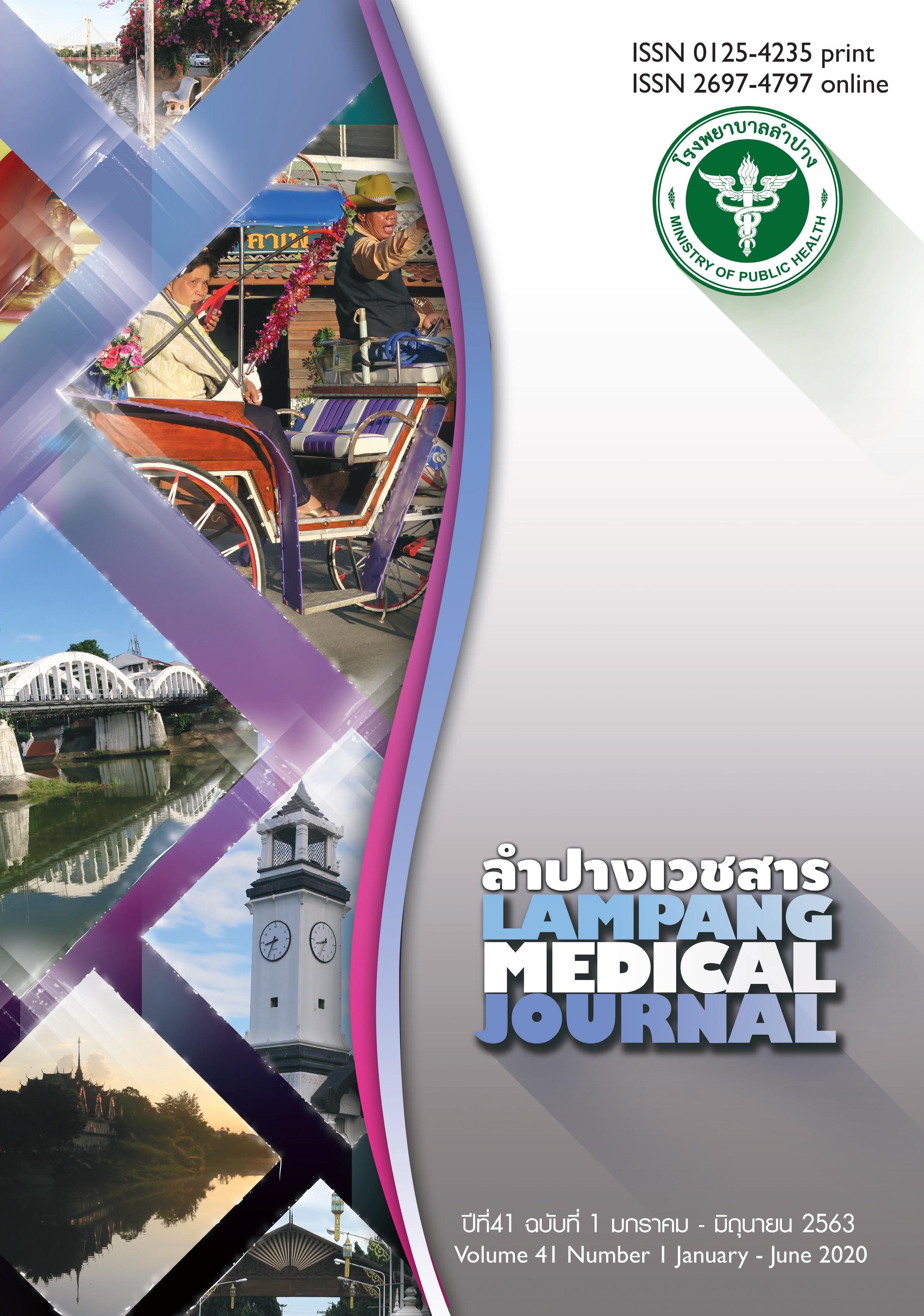Surgical Delay in Healthy Elderly Patients with Hip Fractures : How Many Days are Acceptable?
Main Article Content
Abstract
Background: Acceptable waiting time for surgery in elderly patients with hip fractures is still controversial, especially for those who are healthy or have mild systemic diseases (American Society of Anesthesiologists [ASA] physical status class I-II).
Objective: To determine the acceptable waiting time for surgery, without significantly affecting mortality and morbidity risk, in the ASA class I-II elderly patients with hip fractures.
Material and method: A retrospective cohort study was conducted among ASA class I-II patients aged 60 years and above, who had hip fractures within 7 days before undergoing surgeries at Lampang Hospital from January 2007 to December 2017. The total of 799 patients were divided into 11 groups according to the waiting time for surgery of 0, 1, 2, 3, 4, 5, 6, 7, 8, 9, 10 and more than 10 days. One-year mortality and 30-day morbidity rate were calculated and compared between groups to find the acceptable waiting time that did not cause significant differences in mortality and morbidity.
Results: The patients had an average age of 75.5±7.9 years (range 60-100). 606 patients were female (75.8 %). The average waiting time to surgery was 5.4±3.0 days (range 0-16). 33 patients (4.1%) died within 1 year after the surgery, and 7 patients (0.9%) had complications within 30 days. The group of patients who waited for surgery >4 days had a 30-day complication rate higher than those who had surgery within 4 days (1.6% vs 0%, p=0.021). The patients who waited for >8 days had a 1-year mortality rate higher than those who had
surgery within 8 days (11.2% vs 3.0%, p=0.001). No significant differences in 1-year mortality rate for the groups of patients who waited for 1, 2, 3, 4, 5, 6 and 7 days (p=1.000, 0.339, 0.449, 0.282, 0.859, 0.240 and 0.050 respectively).
Conclusion: Healthy elderly patients with hip fractures could wait up to 8 days to have surgery from the day of being admitted to the hospital, without significantly increasing the 1-year mortality. However, if the surgery was performed within 4 days, the 30-day complication rate could be reduced.
Article Details
บทความที่ส่งมาลงพิมพ์ต้องไม่เคยพิมพ์หรือกำลังได้รับการพิจารณาตีพิมพ์ในวารสารอื่น เนื้อหาในบทความต้องเป็นผลงานของผู้นิพนธ์เอง ไม่ได้ลอกเลียนหรือตัดทอนจากบทความอื่น โดยไม่ได้รับอนุญาตหรือไม่ได้อ้างอิงอย่างเหมาะสม การแก้ไขหรือให้ข้อมูลเพิ่มเติมแก่กองบรรณาธิการ จะต้องเสร็จสิ้นเป็นที่เรียบร้อยก่อนจะได้รับพิจารณาตีพิมพ์ และบทความที่ตีพิมพ์แล้วเป็นสมบัติ ของลำปางเวชสาร
References
มูลนิธิสถาบันวิจัยและพัฒนาผู้สูงอายุไทย. สถานการณ์ผู้สูงอายุไทย พ.ศ. 2561 = Situation of the Thai elderly 2018. กรุงเทพฯ: สถาบันวิจัยประชากรและสังคม มหาวิทยาลัยมหิดล; 2562.
Chaysri R, Leerapun T, Klunklin K, Chiewchantanakit S, Luevitoonvechkij S, Rojanasthien S. Factors related to mortality after osteoporotic hip fracture treatment at Chiang Mai University Hospital, Thailand, during 2006 and 2007. J Med Assoc Thai. 2015;98(1):59–64.
Simunovic N, Devereaux PJ, Sprague S, Guyatt GH, Schemitsch E, Debeer J, et al. Effect of early surgery after hip fracture on mortality and complications: systematic review and meta-analysis. CMAJ. 2010;182(15):1609–16.
Moja L, Piatti A, Pecoraro V, Ricci C, Virgili G, Salanti G, et al. Timing matters in hip fracture surgery: patients operated within 48 hours have better outcomes. A meta-analysis and meta-regression of over 190,000 patients. PLoS ONE. 2012;7(10):e46175.
Holt G, Smith R, Duncan K, Finlayson DF, Gregori A. Early mortality after surgical fixation of hip fractures in the elderly: an analysis of data from the scottish hip fracture audit. J Bone Joint Surg Br. 2008;90(10):1357–63.
Lizaur-Utrilla A, Martinez-Mendez D, Collados-Maestre I, Miralles-Muñoz FA, Marco-Gomez L, Lopez-Prats FA. Early surgery within 2 days for hip fracture is not reliable as healthcare quality indicator. Injury. 2016;47(7):1530–5.
Moran CG, Wenn RT, Sikand M, Taylor AM. Early mortality after hip fracture: is delay before surgery important? J Bone Joint Surg Am. 2005;87(3):483–9.
Doruk H, Mas MR, Yildiz C, Sonmez A, Kýrdemir V. The effect of the timing of hip fracture surgery on the activity of daily living and mortality in elderly. Arch Gerontol Geriatr. 2004;39(2):179–85.
Vidán MT, Sánchez E, Gracia Y, Marañón E, Vaquero J, Serra JA. Causes and effects of surgical delay in patients with hip fracture: a cohort study. Ann Intern Med. 2011;155(4):226–33.
Shoda N, Yasunaga H, Horiguchi H, Matsuda S, Ohe K, Kadono Y, et al. Risk factors affecting inhospital mortality after hip fracture: retrospective analysis using the Japanese Diagnosis Procedure Combination Database. BMJ Open. 2012;2(3):e000416.
Fleiss JL, Levin B, Paik MC. Statistical methods for rates and proportions. 3rded. New Jersey: Wiley; 2003.
Ngamjarus C, Chongsuvivatwong V. n4Studies: Sample size and power calculations for iOS. The Royal Golden Jubilee Ph.D. Program - The Thailand Research Fund & Prince of Songkla University; 2014. (In Thai).
Jiang L, Chou ACC, Nadkarni N, Ng CEQ, Chong YS, Howe TS, et al. Charlson Comorbidity Index Predicts 5-Year Survivorship of Surgically Treated Hip Fracture Patients. Geriatr Orthop Surg Rehabil. 2018;9:1-5.
Holt G, Smith R, Duncan K, Finlayson DF, Gregori A. Early mortality after surgical fixation of hip fractures in the elderly: prospective analysis . J Bone Joint Surg Br. 2008;90(10):1357–63.
Charlson ME, Pompei P, Ales KL, MacKenzie CR. A new method of classifying prognostic comorbidity in longitudinal studies: development and validation. J Chronic Dis. 1987;40(5):373–83.
Detsky AS, Abrams HB, McLaughlin JR, Drucker DJ, Sasson Z, Johnston N, et al. Predicting cardiac complications in patients undergoing non-cardiac surgery. J Gen Intern Med. 1986;1(4):211–9.
Kristensen MT, Foss NB, Ekdahl C, Kehlet H. Prefracture functional level evaluated by the New Mobility Score predicts in-hospital outcome after hip fracture surgery. Acta Orthop. 2010;81(3):296–302.


